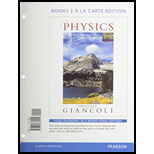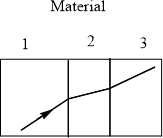
Physics: Principles with Applications, Books a la Carte Edition & Modified Mastering Physics with Pearson eText -- ValuePack Access Card Package
1st Edition
ISBN: 9780321974990
Author: Douglas C. Giancoli
Publisher: PEARSON
expand_more
expand_more
format_list_bulleted
Concept explainers
Question
Chapter 23, Problem 14Q
To determine
(a) To determine:
The material which has the largest index of refraction, if a ray of light is refracted through three different materials

To determine
(b) To determine:
The material which has the smallest index of refraction if a ray of light is refracted through three different materials

Expert Solution & Answer
Want to see the full answer?
Check out a sample textbook solution
Students have asked these similar questions
3AA . not sure what i am getting wrong
6b
1a angle of -A and 6b angle of A and Angle of -A. Need help
Chapter 23 Solutions
Physics: Principles with Applications, Books a la Carte Edition & Modified Mastering Physics with Pearson eText -- ValuePack Access Card Package
Ch. 23 - Prob. 1OQCh. 23 - Prob. 2OQCh. 23 - Prob. 1QCh. 23 - What is the focal length of a plane mirror? What...Ch. 23 - Prob. 3QCh. 23 - Prob. 4QCh. 23 - Prob. 5QCh. 23 - Prob. 6QCh. 23 - Prob. 7QCh. 23 - Prob. 8Q
Ch. 23 - Prob. 9QCh. 23 - Prob. 10QCh. 23 - Prob. 11QCh. 23 - You look into an aquarium and view a fish inside....Ch. 23 - Prob. 13QCh. 23 - Prob. 14QCh. 23 - A child looks into a pool to see how deep it is....Ch. 23 - Prob. 16QCh. 23 - Prob. 17QCh. 23 - Prob. 18QCh. 23 - Prob. 19QCh. 23 - Prob. 20QCh. 23 - Prob. 21QCh. 23 - Prob. 22QCh. 23 - Prob. 23QCh. 23 - Prob. 24QCh. 23 - Prob. 25QCh. 23 - Prob. 26QCh. 23 - Prob. 27QCh. 23 - Prob. 28QCh. 23 - Prob. 29QCh. 23 - Prob. 30QCh. 23 - Prob. 31QCh. 23 - Prob. 32QCh. 23 - Prob. 1MCQCh. 23 - Prob. 2MCQCh. 23 - Prob. 3MCQCh. 23 - Prob. 4MCQCh. 23 - Prob. 5MCQCh. 23 - Prob. 6MCQCh. 23 - Prob. 7MCQCh. 23 - Prob. 8MCQCh. 23 - Prob. 9MCQCh. 23 - Prob. 10MCQCh. 23 - Prob. 11MCQCh. 23 - Prob. 12MCQCh. 23 - Prob. 13MCQCh. 23 - Prob. 14MCQCh. 23 - Prob. 1PCh. 23 - Prob. 2PCh. 23 - Two plane mirrors meet at a 1350 angle, Fig....Ch. 23 - Prob. 4PCh. 23 - Prob. 5PCh. 23 - Prob. 6PCh. 23 - Suppose you are 94 cm from a plane mirror. What...Ch. 23 - A solar cooker, really a concave mirror pointed at...Ch. 23 - How far from a concave mirror (radius 21.0 cm)...Ch. 23 - A small candle is 38 cm from a concave mirror...Ch. 23 - An object 3.0 mm high is placed 16 cm from a...Ch. 23 - A dentist wants a small mirror that, when 2.00 cm...Ch. 23 - You are standing 3.4 m from a convex security...Ch. 23 - The image of a distant tree is virtual and very...Ch. 23 - Prob. 15PCh. 23 - Prob. 16PCh. 23 - Prob. 17PCh. 23 - Some rearview mirrors produce images of cars to...Ch. 23 - Prob. 19PCh. 23 - Prob. 20PCh. 23 - Prob. 21PCh. 23 - Prob. 22PCh. 23 - Prob. 23PCh. 23 - Prob. 24PCh. 23 - Prob. 25PCh. 23 - Prob. 26PCh. 23 - Prob. 27PCh. 23 - Prob. 28PCh. 23 - Prob. 29PCh. 23 - Prob. 30PCh. 23 - Rays of the Sunare seen to make a 36.0° angle to...Ch. 23 - Prob. 32PCh. 23 - A beam of light in air strikes a slab of glass (n...Ch. 23 - Prob. 34PCh. 23 - Prob. 35PCh. 23 - Prob. 36PCh. 23 - Prob. 37PCh. 23 - Prob. 38PCh. 23 - 39. (Ill) (a) What is the minimum index of...Ch. 23 - 40. (Ill) A beam of light enters the end of an...Ch. 23 - Prob. 41PCh. 23 - Prob. 42PCh. 23 - Prob. 43PCh. 23 - Prob. 44PCh. 23 - Prob. 45PCh. 23 - Prob. 46PCh. 23 - A stamp collector uses a converging lens with...Ch. 23 - Prob. 48PCh. 23 - Prob. 49PCh. 23 - Prob. 50PCh. 23 - Prob. 51PCh. 23 - Prob. 52PCh. 23 - Prob. 53PCh. 23 - Prob. 54PCh. 23 - Prob. 55PCh. 23 - Prob. 56PCh. 23 - Prob. 57PCh. 23 - A diverging lens with f= -36.5 cm is placed 14.0...Ch. 23 - Prob. 59PCh. 23 - Prob. 60PCh. 23 - Two lenses, one converging with focal length 20.0...Ch. 23 - Prob. 62PCh. 23 - A double concave lens has surface radii of 33.4 cm...Ch. 23 - Prob. 64PCh. 23 - Prob. 65PCh. 23 - Prob. 66PCh. 23 - Prob. 67PCh. 23 - Prob. 68PCh. 23 - Prob. 69GPCh. 23 - Prob. 70GPCh. 23 - Prob. 71GPCh. 23 - The critical angle of a certain piece of plastic...Ch. 23 - Prob. 73GPCh. 23 - Prob. 74GPCh. 23 - Prob. 75GPCh. 23 - Prob. 76GPCh. 23 - 77
77. If the apex of a prism is ? = 75o (see...Ch. 23 - Prob. 78GPCh. 23 - Prob. 79GPCh. 23 - Prob. 80GPCh. 23 - Prob. 81GPCh. 23 - Prob. 82GPCh. 23 - Prob. 83GPCh. 23 - Figure 23-65is a photograph of an eyeball with the...Ch. 23 - Prob. 85GPCh. 23 - Prob. 86GPCh. 23 - 87 ‘(a) Show that if two thin lenses of focal...Ch. 23 - Prob. 88GPCh. 23 - Prob. 89GPCh. 23 - Prob. 90GP
Additional Science Textbook Solutions
Find more solutions based on key concepts
2. Whether an allele is dominant or recessive depends on
a. how common the allele is, relative to other alleles...
Campbell Biology: Concepts & Connections (9th Edition)
17. A speed skater moving to the left across frictionless ice at 8.0 m/s hits a 5.0-m-wide patch of rough ice....
Physics for Scientists and Engineers: A Strategic Approach, Vol. 1 (Chs 1-21) (4th Edition)
3. In a test of his chromosome theory of heredity, Morgan crossed an F1 female Drosophila with red eyes to a m...
Genetic Analysis: An Integrated Approach (3rd Edition)
18. A fast pitch softball player does a “windmill” pitch, illustrated in Figure P6.18. moving her hand through ...
College Physics: A Strategic Approach (3rd Edition)
EVOLUTION CONNECTION Crossing over is thought to be evolutionarily advantageous because it continually shuffles...
Campbell Biology (11th Edition)
1.14 Classify each of the following as a pure substance or a mixture. If a mixture, indicate whether it is homo...
Chemistry: The Central Science (14th Edition)
Knowledge Booster
Learn more about
Need a deep-dive on the concept behind this application? Look no further. Learn more about this topic, physics and related others by exploring similar questions and additional content below.Similar questions
arrow_back_ios
SEE MORE QUESTIONS
arrow_forward_ios
Recommended textbooks for you
 College PhysicsPhysicsISBN:9781305952300Author:Raymond A. Serway, Chris VuillePublisher:Cengage Learning
College PhysicsPhysicsISBN:9781305952300Author:Raymond A. Serway, Chris VuillePublisher:Cengage Learning University Physics (14th Edition)PhysicsISBN:9780133969290Author:Hugh D. Young, Roger A. FreedmanPublisher:PEARSON
University Physics (14th Edition)PhysicsISBN:9780133969290Author:Hugh D. Young, Roger A. FreedmanPublisher:PEARSON Introduction To Quantum MechanicsPhysicsISBN:9781107189638Author:Griffiths, David J., Schroeter, Darrell F.Publisher:Cambridge University Press
Introduction To Quantum MechanicsPhysicsISBN:9781107189638Author:Griffiths, David J., Schroeter, Darrell F.Publisher:Cambridge University Press Physics for Scientists and EngineersPhysicsISBN:9781337553278Author:Raymond A. Serway, John W. JewettPublisher:Cengage Learning
Physics for Scientists and EngineersPhysicsISBN:9781337553278Author:Raymond A. Serway, John W. JewettPublisher:Cengage Learning Lecture- Tutorials for Introductory AstronomyPhysicsISBN:9780321820464Author:Edward E. Prather, Tim P. Slater, Jeff P. Adams, Gina BrissendenPublisher:Addison-Wesley
Lecture- Tutorials for Introductory AstronomyPhysicsISBN:9780321820464Author:Edward E. Prather, Tim P. Slater, Jeff P. Adams, Gina BrissendenPublisher:Addison-Wesley College Physics: A Strategic Approach (4th Editio...PhysicsISBN:9780134609034Author:Randall D. Knight (Professor Emeritus), Brian Jones, Stuart FieldPublisher:PEARSON
College Physics: A Strategic Approach (4th Editio...PhysicsISBN:9780134609034Author:Randall D. Knight (Professor Emeritus), Brian Jones, Stuart FieldPublisher:PEARSON

College Physics
Physics
ISBN:9781305952300
Author:Raymond A. Serway, Chris Vuille
Publisher:Cengage Learning

University Physics (14th Edition)
Physics
ISBN:9780133969290
Author:Hugh D. Young, Roger A. Freedman
Publisher:PEARSON

Introduction To Quantum Mechanics
Physics
ISBN:9781107189638
Author:Griffiths, David J., Schroeter, Darrell F.
Publisher:Cambridge University Press

Physics for Scientists and Engineers
Physics
ISBN:9781337553278
Author:Raymond A. Serway, John W. Jewett
Publisher:Cengage Learning

Lecture- Tutorials for Introductory Astronomy
Physics
ISBN:9780321820464
Author:Edward E. Prather, Tim P. Slater, Jeff P. Adams, Gina Brissenden
Publisher:Addison-Wesley

College Physics: A Strategic Approach (4th Editio...
Physics
ISBN:9780134609034
Author:Randall D. Knight (Professor Emeritus), Brian Jones, Stuart Field
Publisher:PEARSON